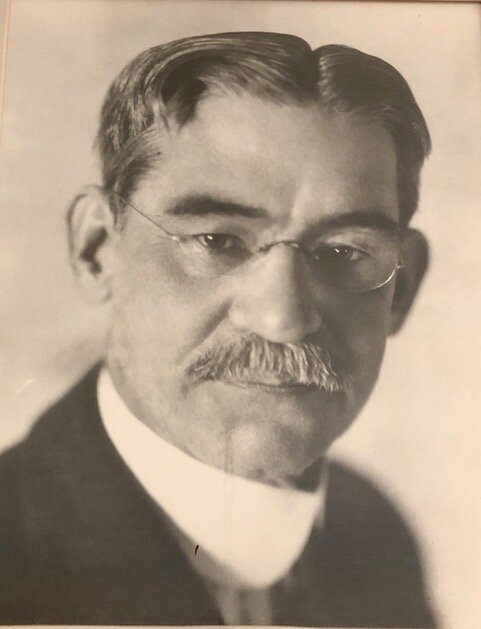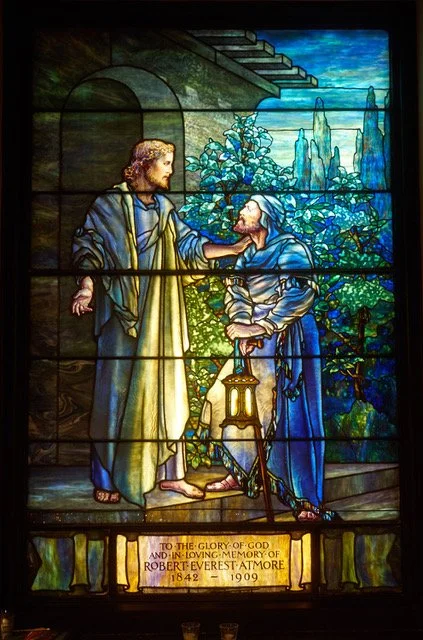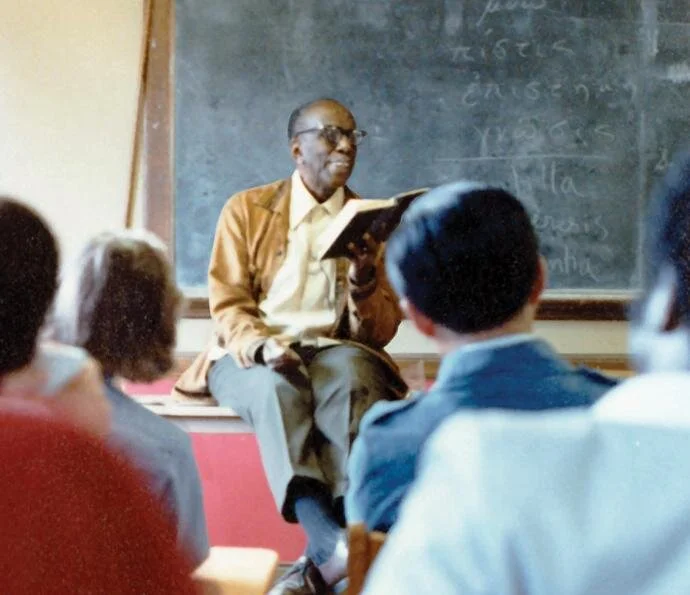Friday Reflection Part II: Introducing Dr. Carl E. Grammer’s Unsung Work for Civil and Human Rights
The Rev. Dr. Carl E. Grammer
The call to service for civil and human rights in the United States has engaged many people of faith and, very prominently, celebrated ordained ministers. Yet there are those who are less widely known today for their participation. One such—why am I not surprised?—is St. Stephen’s rector whom we’ve considered repeatedly in these Reflections, The Rev. Dr. Carl E. Grammer (1858-1944). Dr. Grammer’s civil-rights service in fact provides a crucial perspective into this complex movement’s early years, so it’s worth outlining here. There’s also enough available in lockdown to offer some significant points and questions to explore further.
Called to St. Stephen’s from 1905 through 1936 as the movement gained momentum, Dr. Grammer was one of the many liberal whites who openly supported and helped to organize it in its first years. At his peak as an Episcopal minister, he engaged, with considerable authority and presence, with at least three different facets of civil rights action: for African-Americans, Native Americans, and women.
African American civil rights, by 1908
Remarkably, Dr. Grammer rests at the base of a tree that grew into the NAACP. Three years into his rectorship at St. Stephen’s, Dr. Grammer was serving as president of the new Armstrong Association for the Advancement of the Colored Race, one of several Philadelphia organizations for blacks named after Samuel Chapman Armstrong, white commander of African-American Union troops who then founded what is now Hampton University (Hampton, VA) for African and Native Americans. All these groups served especially the new arrivals with the Great Migration from the Reconstruction South, leading to what many called the “Negro problem” here, notably crime and poverty as racist lynchings and violence erupted elsewhere. The AACP prefigured what became the NAACP founded 1909-10 in New York as regional forces began to work together; it is now often described as a “branch” of the NAACP. An emerging African-American luminary, Richard Robert Wright, Jr. worked in the field under Dr. Grammer at the AACP but soon left over differences concerning housing.
In his memoir, Wright said he supported self-help (self-financing, etc.) over Dr. Grammer’s preference for social services (charity) by dominant whites. The disagreement reflects divisions within the movement, notably between leaders Booker T. Washington and W.E.B. DuBois (Grammer’s priorities contain elements of both). The plans of the younger Wright (with advanced degrees from Germany like DuBois, University of Chicago, soon the first black PHD in Sociology at the University of Pennsylvania, and eventually a Baptist minister and bishop) would be implemented and developed later. Yet Dr. Grammer’s views can also be interpreted, as Wright proposed, as those of a Southern white who thought he knew “all about Negroes.”
Dr. Grammer’s vision at that date, including on charity, might also be traced to his Southern Evangelical family roots that sought to live the Gospel--as they saw it in their world. His father, The Rev. Dr. Julius E. Grammer, was a prominent Evangelical minister in Baltimore; his maternal grandfather was the eminent Rev. Dr. William Sparrow, dean of the Episcopal seminary in Alexandria, VA (informally called the Virginia Theological Seminary [VTS]) where Dr. Grammer later studied and taught.
Though an obituary lists him as “honorary” president of the AACP, suggesting a long-term relationship, it’s not clear how long Dr. Grammer remained with the organization or with any other black civil-rights groups. But then, we know even less about any service before he arrived in Philadelphia. How, when, and why did he move into civil rights?
Native American Advocacy.
By 1913, a Google search revealed, Dr. Grammer was president of the Indian Rights Association (IRA), an advocacy group in Philadelphia, again of liberal whites, founded in 1882 to support the well-being and “acculturation” of Native Americans, that remained influential through the 1930s until 1994, when Native American organizations gained ascendancy.
The IRA’s initial priority was to assimilate tribes into a white Protestant United States, but goals evolved over time. To what by 1913? Despite their missionary zeal, they had become the most effective lobbying force for Native Americans in Washington. Online sources reveal Dr. Grammer’s skills as a relentless advocate before the federal powers on legal matters surrounding Native American land. We see his letters protesting the action of the Interior Department in forcing the Standing Rock Indians to lease their lands to cattle syndicates for grazing, ignoring the government’s policy backing the community’s self-determination and pursuit of agriculture. Other letters object to the use of public funds for sectarian schools among the Sioux and others. The Church News of 1913 claims Dr. Grammer supported a relationship between Church and state, as a defense of Indians’ rights—but what relationship?
For Native Americans, Dr. Grammer became an articulate advocate for civil rights and legislation in the language of the law. Though rarely mentioned, he studied law (possibly at the Francis King Carey School of Law, University of Maryland, c. 1880-1883) and practiced briefly before turning in 1884 to prepare for ordination. He fused his two vocations when teaching Canon Law for 11 years at VTS.
Voting rights for women, 1915-
At the same time, Dr. Grammer made the city news (Philadelphia Inquirer; philadelphiastudies.org) for strongly supporting women’s suffrage before the Clerical Brotherhood. Among his defenses: (1) He could find “nothing . . . in all his research that presented a strong argument against . . . [their voting];” and (2) “The representative system of government demands that women be represented in legislation.” His comments fundamentally judge arguments and language.
So where does Dr. Grammer’s engagement with civil rights fit into his life? His obituaries largely pass over this activity; one simply cites his “honorary” presidency of the AACP. The Rev. Leicester C. Lewis’ memorial sermon at St. Stephen’s (philadelphiastudies.org) makes no mention of this activity at all. There, his ministry, Church, and faith take center stage. Was the push for civil rights an extension of his ministry or the action of the engaged Christian? Did he pursue Christian charity as a Southern white Evangelical, as R.R. Wright claimed, or Old Testament justice? Perhaps his many publications can tell us more.
What seems clear is that Dr. Grammer acted as he thought, as a man of living faith. As we’ve seen in prior Reflections, he could defy fellow rectors, who protested closure of churches during the 1918 influenza pandemic, to instead assert God’s presence everywhere especially in crisis. He believed in his Church and taught its history and law at a distinguished seminary for more than a decade. Faith, in addition to a probing intellect, perhaps enabled the startling doctrinal leaps of this Evangelical Episcopalian who publicly upheld science, reason—and the plausibility of miracles and the divinity of Christ.
Dr. Grammer tested ideas and shifted position, yet held fast to a foundation. In a late public review of his religious thought as a Bohlen Lecture in 1928 (All That Remains, 1929), he described himself as having evolved theologically from the profoundly anti-Catholic Evangelism of his birth to an abidingly anti-Catholic liberal (though still ecclesiastically Evangelical) who took the New Biblical Criticism seriously.
There is much to learn. Dr. Grammer was probably as controversial as he was forceful. But his life, faith, and call to service proved inseparable as they engaged with the turmoil of his time.
—Suzanne Glover Lindsay, St. Stephen’s historian and curator
About Friday Reflections:
Every Friday, Father Peter and Suzanne Glover Lindsay share written reflections highlighting a particular theme. Check out Friday Reflection Part I, where Father Peter considers Thurgood Marshall.










